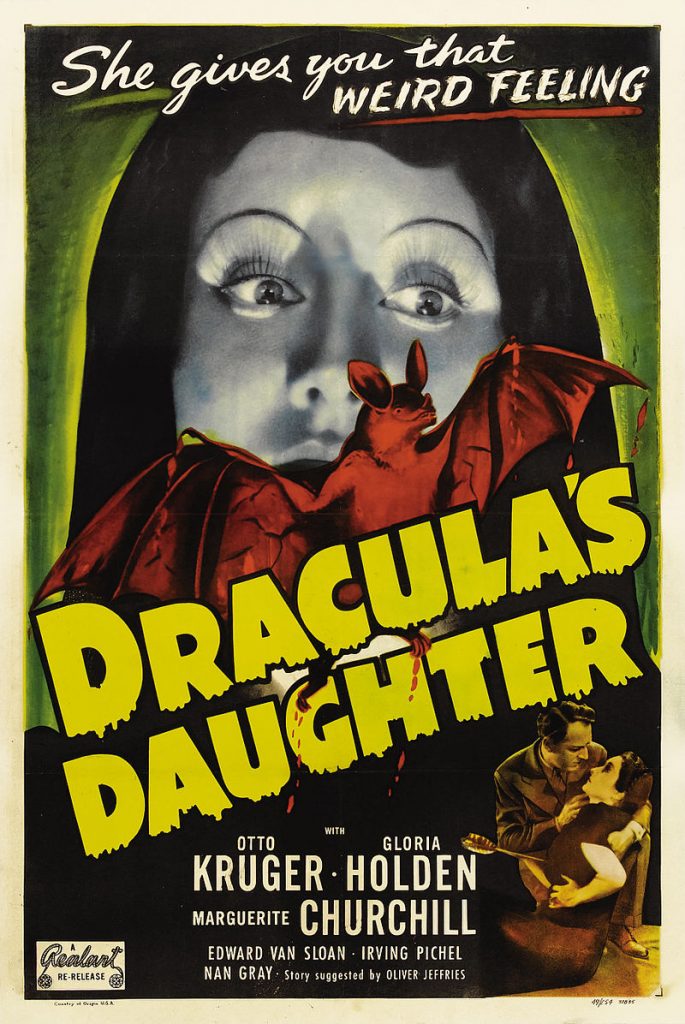SHE’S WEIRD! SHE’S EXTOTIC! SHE’S HYPTONIC!
(print ad – Lubbock Morning Avalanche – Lyric Theatre – Lubbock, Texas – October 13,1936 – all caps)
When Countess Marya Zaleska appears in London, mysterious events occur leading Dr. Von Helsing to believe the Countess must be a vampire.
Nestled in the heart of cinematic history, “Dracula’s Daughter” (1936) stands as a mesmerizing testament to the enduring allure of classic horror films. With the shadow of its predecessor, “Dracula” (1931), looming large, this cinematic masterpiece dared to venture into uncharted territory and left an indelible mark on the genre. As you plunge into this gripping narrative, you’ll discover the chilling legacy of the Count Dracula himself, embodied in his enigmatic and beguiling daughter, Countess Marya Zaleska.
In the wake of Count Dracula’s demise, the audience is thrust into a world where the supernatural meets the psychological. “Dracula’s Daughter” picks up right where the original left off, with Countess Marya Zaleska (played by Gloria Holden) struggling to come to terms with her vampiric nature. This introspective and character-driven approach offers a unique twist, making the film a must-watch for those who seek to delve into the psychology of vampirism.
Gloria Holden’s performance as Countess Marya Zaleska is nothing short of spectacular. Her portrayal of a tortured vampire yearning for redemption adds depth to the character. Holden’s ability to convey the Countess’s inner turmoil and the battle between her desire for salvation and her vampiric hunger is truly a sight to behold. Her portrayal is a testament to the film’s commitment to exploring the emotional complexity of the supernatural.
The film’s production values, especially its art direction and cinematography, are laudable. The gothic ambiance and eerie landscapes serve as the perfect backdrop for the unfolding narrative. The use of shadows and lighting to build tension is a masterclass in visual storytelling. It’s a prime example of how the horror genre can employ subtlety and atmosphere to create spine-tingling moments.
“Dracula’s Daughter” is also notable for its subtle and often subtext-laden approach to LGBTQ+ themes. Countess Marya Zaleska’s quest for a cure and her unconventional, almost maternal relationship with her assistant Sandor (played by Irving Pichel) offer a nuanced exploration of otherness, identity, and societal acceptance, all wrapped within a compelling horror narrative.
Furthermore, the film’s legacy extends beyond its initial release. “Dracula’s Daughter” is a testament to the idea that classic horror never truly dies. Its influence can be seen in modern vampire-themed movies and series, which continue to explore the complexities of vampirism and the struggle for redemption.
In conclusion, “Dracula’s Daughter” (1936) remains a timeless classic that transcends the boundaries of its era. It’s a cinematic jewel that combines psychological depth with gothic allure, offering a compelling and thought-provoking experience for fans of horror and cinema alike. Dive into the enigmatic world of Countess Marya Zaleska and unravel the mysteries of her undying charm—this is one classic horror gem that deserves to be unearthed time and time again.

Cast
The cast of “Dracula’s Daughter” (1936) featured a talented ensemble of actors and actresses who brought the characters to life with remarkable performances. Here are some of the key cast members:
- Gloria Holden as Countess Marya Zaleska: Gloria Holden portrayed the titular character, Countess Marya Zaleska, the enigmatic daughter of Count Dracula. Her performance as a conflicted and tormented vampire seeking redemption left a lasting impression.
- Otto Kruger as Dr. Jeffrey Garth: Otto Kruger played Dr. Jeffrey Garth, a psychiatrist who becomes entangled in the supernatural events surrounding Countess Zaleska. His character adds an element of rationality and scientific inquiry to the story.
- Marguerite Churchill as Janet Blake: Marguerite Churchill took on the role of Janet Blake, Dr. Garth’s secretary and romantic interest. Her character provides a sense of normalcy and serves as a foil to the film’s supernatural elements.
- Edward Van Sloan as Professor Von Helsing: Edward Van Sloan reprised his role as Professor Abraham Van Helsing from the 1931 film “Dracula.” He provides a connection to the original film and plays a pivotal role in the narrative.
- Irving Pichel as Sandor: Irving Pichel portrayed Sandor, Countess Zaleska’s loyal and mysterious assistant. His character is instrumental in the unfolding of the plot.
- Halliwell Hobbes as Hawkins: Halliwell Hobbes played Hawkins, a Scotland Yard inspector who becomes involved in the investigation of the supernatural occurrences.

 Buy me a coffee
Buy me a coffee